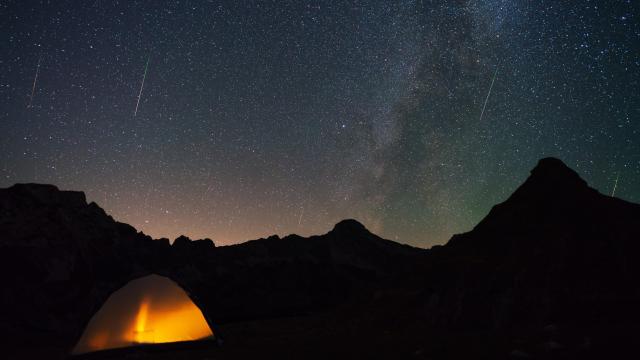Celestial events are often momentary, which is why the most determined stargazers will stay up at odd hours and even venture out into uncomfortable conditions to catch a glimpse of the ephemeral wonders. But every winter, the Perseid meteor shower darts across the evening sky for more than a month, leaving even the most lukewarm astronomy buffs with little excuse to miss out on the show unfolding right above their very heads.
The annual meteor shower is back, and as a nearly six-week procession of burning rocks screaming through the cosmos, we’re pretty lucky to have it.
What is the Perseid meteor shower?
The Perseids flash across the evening sky every year, usually between mid-t0-late July and mid-August. This year, the shower will peak between August 11th and 13th, when a cascade of meteors jet through the ether at a clip of nearly 100 per hour.
This particularly shower isn’t to be overlooked, as it’s largely hailed as the best celestial show of the year. The Perseids are the leftover debris of the comet 109P/Swift-Tuttle, which takes a lumbering course around the sun every 133 years, according to NASA. Our planet traverses the trail of meteoroids left behind in the comet’s wake every summer, creating the Perseid meteor shower. The Swift-Tuttle is a behemoth with a nucleus of 26 km across, which NASA puts into perspective this way: “This is almost twice the size of the object hypothesised to have led to the demise of the dinosaurs.”
The shower is named after its nearest constellation — Perseus — which is the Perseid’s radiant, or the closest star that illuminates a meteor shower. This particular shower is known for casting long streaks that follow the meteoroids as they careen through space (a meteoroid is called as such when it’s in space; only when it hits Earth’s atmosphere does it become classified as a meteor). On average, there are about 60 space rocks flying by per hour, but the number can crest upwards of 100 at the shower’s peak.
Another reason the Perseid’s are noteworthy: fireballs. NASA explains how the shower creates these:
Fireballs are larger explosions of light and colour that can persist longer than an average meteor streak. This is due to the fact that fireballs originate from larger particles of cometary material.
Despite the spectacle they generate, the Perseids are actually “about the size of a sand grain,” according to Space.com. The tiny specks travel at the blinding pace of 214,365 km/h and can reach a temperature of around 3,000℉.
How to see the Perseids
Viewing instructions are pretty simple, as long as you’re positioned in the Northern Hemisphere. NASA instructs hopefuls to venture outside “during the pre-dawn hours, though at times it is possible to view meteors from this shower as early as 10 p.m.” Finding a clear sky free of light pollution is, of course, one of the best practices for optimal viewing.
Although this shower technically starts tomorrow (July 14), it’ll only get better as July turns into August. Carve some space out on your calendar — it will be well worth your time.
Note: Those in the Southern Hemisphere won’t get a good view of the Perseids meteor shower but might be able to catch a glimpse in the early hours of the morning from 3 am.

Leave a Reply
You must be logged in to post a comment.